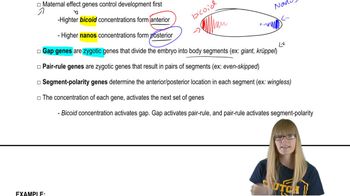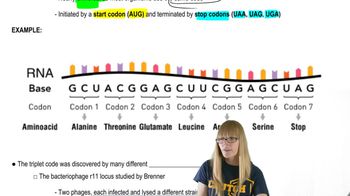Table of contents
- 1. Introduction to Genetics51m
- 2. Mendel's Laws of Inheritance3h 37m
- 3. Extensions to Mendelian Inheritance2h 41m
- 4. Genetic Mapping and Linkage2h 28m
- 5. Genetics of Bacteria and Viruses1h 21m
- 6. Chromosomal Variation1h 48m
- 7. DNA and Chromosome Structure56m
- 8. DNA Replication1h 10m
- 9. Mitosis and Meiosis1h 34m
- 10. Transcription1h 0m
- 11. Translation58m
- 12. Gene Regulation in Prokaryotes1h 19m
- 13. Gene Regulation in Eukaryotes44m
- 14. Genetic Control of Development44m
- 15. Genomes and Genomics1h 50m
- 16. Transposable Elements47m
- 17. Mutation, Repair, and Recombination1h 6m
- 18. Molecular Genetic Tools19m
- 19. Cancer Genetics29m
- 20. Quantitative Genetics1h 26m
- 21. Population Genetics50m
- 22. Evolutionary Genetics29m
11. Translation
The Genetic Code
Problem 15
Textbook Question
Refer to Figure 13.7 to respond to the following:
Shown here is a hypothetical viral mRNA sequence:
5'-AUGCAUACCUAUGAGACCCUUGGA-3'
Assuming that it could arise from overlapping genes, how many different polypeptide sequences can be produced? What are the sequences?
 Verified step by step guidance
Verified step by step guidance1
Identify the reading frames: Since the mRNA sequence is given, determine the possible reading frames. There are three possible reading frames for the 5' to 3' direction.
Translate each reading frame: For each reading frame, translate the nucleotide sequence into amino acids using the genetic code table. Start from the first nucleotide for the first reading frame, the second nucleotide for the second reading frame, and the third nucleotide for the third reading frame.
Consider overlapping genes: Overlapping genes can result in different polypeptides from the same mRNA sequence. Ensure to check each reading frame for potential start codons (AUG) and stop codons (UAA, UAG, UGA).
Determine the polypeptide sequences: For each reading frame, identify the start and stop codons to determine the possible polypeptide sequences. Translate the codons between the start and stop codons into amino acids.
Count the unique sequences: After identifying the possible polypeptide sequences from each reading frame, count the number of unique sequences that can be produced.
Recommended similar problem, with video answer:
 Verified Solution
Verified SolutionThis video solution was recommended by our tutors as helpful for the problem above
Video duration:
2mPlay a video:
Was this helpful?
Key Concepts
Here are the essential concepts you must grasp in order to answer the question correctly.
Overlapping Genes
Overlapping genes occur when two or more genes share some of the same nucleotide sequences in their coding regions. This can lead to the production of multiple polypeptides from a single mRNA strand, as different reading frames can be utilized. Understanding how these genes overlap is crucial for determining the potential polypeptide sequences that can be generated from a given mRNA.
Recommended video:
Guided course

Segmentation Genes
Reading Frames
A reading frame refers to the way nucleotides in an mRNA sequence are divided into codons, which are groups of three nucleotides that correspond to specific amino acids. There are three possible reading frames for any given mRNA sequence, depending on where translation begins. Identifying all possible reading frames is essential for predicting the different polypeptide sequences that can be synthesized from the mRNA.
Recommended video:
Guided course

The Genetic Code
Polypeptide Synthesis
Polypeptide synthesis is the process by which ribosomes translate mRNA sequences into polypeptides, which are chains of amino acids. Each codon in the mRNA corresponds to a specific amino acid, and the sequence of codons determines the order of amino acids in the resulting polypeptide. Understanding this process is vital for analyzing how many distinct polypeptides can be produced from a single mRNA sequence, especially in the context of overlapping genes.
Recommended video:
Guided course

Translesion Synthesis

 11:43m
11:43mWatch next
Master The Genetic Code with a bite sized video explanation from Kylia Goodner
Start learningRelated Videos
Related Practice

